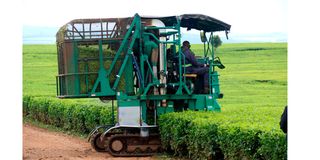How automation is pushing more women than men out of jobs

Workers use a tea-plucking machine on a plantation in Kericho on June 30, 2022.
What you need to know:
- The Covid-19 crisis showed that women are more likely to lose jobs during periods of economic upheaval, and are slower to return to the workforce.
- A 2019 study from Britain found that 70 per cent of jobs at high risk from automation are held by women.
Rose Nyunja was just 18 when she began working on the tea plantations of Kericho, Kenya’s biggest tea-growing region and a major source of employment for poor women. For decades, she toiled away picking the leaves by hand.
Then came the harvesting machinery. Women like Nyunja started to lose their jobs by the thousands to machines that could each replace more than 100 workers. One evening in 2020, Nyunja returned to the staff quarters to find her front door barricaded. She’d been fired. Nyunja pleaded with her supervisor to save her job—and her home. Instead, company security ejected her from the compound.
“My 26 years of service meant nothing to them,” she says, fighting back tears. “I was given one hour to remove my household items and leave. I have never experienced such humiliation and embarrassment in my life. I worked diligently for over two decades and what have I got? Nothing.”
As Kenya’s tea estates automate to improve productivity, workers like Nyunja represent a broader global trend: women are more likely than men to lose their jobs. A 2019 study from Britain found that 70 per cent of jobs at high risk from automation are held by women. And this April, a University of North Carolina study found that almost 80 per cent of the female workforce in the US will be affected by advances in generative artificial intelligence (AI), compared to 58 per cent of men.
While recent advances in generative AI have sharpened concerns about loss of jobs for white-collar workers, job losses due to companies ramping up automation have been taking place for years, as seen in Kenya. Kweilin Ellingrud, a director at McKinsey Global Institute, says her research shows that automation is 14 times more likely to impact low-wage workers than high earners.
“I think the reason it’s grabbing headlines is that it is also affecting higher wage jobs for the first time,” says Ellingrud. “I think now generative AI is focusing and impacting jobs across the spectrum—it affects your job; it affects my job. Some of us, myself included, aren’t used to thinking: ‘How will my work have to change? How will my job change?’”

Tea pickers in Kericho. More than 800 tea pickers have been sent home after a multinational company in Kenya introduced tea picking machines.
In Kericho, Roselyne Wasike, a tea picker, says her income has fallen by almost half, from $150 (Sh22,600) to $80 (Sh12,100) a month, as the machines take over larger shares of work on the plantation. Even those who have managed to keep their jobs cannot escape the impact of automation. Many of them are widows and single mothers.
“These machines have disadvantaged women by making them redundant instead of giving them other tasks on the tea estates,” Wasike says.
The Kenya Plantation and Agricultural Workers Union says 30,000 women have lost their jobs as a result of automation in the past five years. About 60 per cent of the 75,000 workers currently employed in the tea sector are women, down from about 75 per cent in 2017, according to Dickson Sang, the secretary-general of the union.
The resentment towards the machines boiled over into violence this May. Kericho residents torched nine harvesting machines worth $1.2 million (Sh181 million) on a plantation owned by Ekaterra, the producer of Lipton and TAZO teas. The clash resulted in two deaths and the arrest of Kericho’s governor. Ekaterra suspended operations for two weeks, leaving more than 16,000 employees without work.
One of the areas of dispute had been a provision in the industry’s collective bargaining agreement that workers, most of whom are women, would be kept on as machine operators. Labour leaders say multinationals have “flatly refused” to implement this.
“I do not condone the destruction of property. But these workers are now fighting back because the tea firms keep moving the goalposts,” says Sang.
Ellingrud says 85 per cent of jobs impacted by generative AI will be concentrated in four job categories: food services, customer service and sales, office administration, and manufacturing. The first three are dominated by women. Even in manufacturing, women workers like Nyunja are more vulnerable than men, who have a higher chance of being retrained for roles involving automation.
The Covid-19 crisis showed that women are more likely to lose jobs during periods of economic upheaval, and are slower to return to the workforce. Ellingrud says: “Women’s unemployment is stickier.”
Her research at McKinsey has found that 12 million people will need to switch jobs by 2030, and that women are 1.5 times more likely than men to have to change their occupation. She says this means governments and businesses need to urgently take targeted actions to re-skill and up-skill women.
Garment industry
Automation has also radically changed the makeup of Bangladesh’s garment industry, once hailed for transforming women’s employment prospects. Women once made up over 80 per cent of the garment workforce; today they account for less than 60 percent. In 2019 the government projected that half a million garment workers, mostly women, would lose their jobs to automation.
At Moni Garment and Training Centre in Savar, a garment hub north of the capital Dhaka, Mizanur Rahman drills his trainees in how to operate machines used for weaving and knitting. A former garment worker himself, he says being sensitive to small areas of concern goes a long way towards making women feel more comfortable. This includes hiring female instructors for female trainees and offering flexible hours so that women can show up before or after taking care of household chores. He says the confidence women gain from their training can lead to increased recognition at work.
“Many of my trainees perform well and are promoted to supervisor or line chief positions,” Rahman says.

Report says that by 2030, nearly eight in 10 women will be forced to move to another company or lose their job due to AI and automation.
Supervisory roles and roles operating automated technology are likely to be among the key jobs that survive in a post-automation landscape. Both tend to be dominated by men. In Bangladesh’s garment industry, women have long made up less than 5 per cent of supervisors, despite being a significant majority of the workforce.
There have been some signs of success. The Gender Equality and Returns project, run by the World Bank’s International Finance Corporation and the International Labour Organisation, says 60 per cent of its trainees have been promoted to supervisory positions, and the number of female supervisors in the industry has jumped to 12 per cent since the program began in 2016.
Abdullah Hil Rakib, a director at the Bangladesh Garment Manufacturers and Exporters Association, the country’s largest trade association for the industry, says the key obstacle to women thriving in supervisory or machine operator roles is psychological. “It’s a barrier in our mindset,” he says.
He points out that automation means less physically strenuous work for both men and women, eliminating one barrier that would have previously made some jobs less accessible for women. “Even when a man runs a heavy automatic cutter machine, he only pushes a switch on and off. He does not need to do more,” Rakib says.
Ellingrud says about 10 per cent of jobs created every year tend to be new roles that didn’t exist before, but women take up these jobs at a lower rate than men. People won’t be losing their jobs to AI, she says, but to people who know how to use AI; women who are unable to adapt risk being left out of the new economy.
Adaptation feels like a distant prospect in Kericho, where Nyunja hawks vegetables to make ends meet. “I used to be able to take care of my family and pay my children’s school fees,” Nyunja says. “Now my future looks bleak. I can barely pay my rent, let alone send my child to school.”
Maher Sattar contributed reporting from New York.
This story is published in partnership with The Fuller Project and co-published with Foreign Policy.




